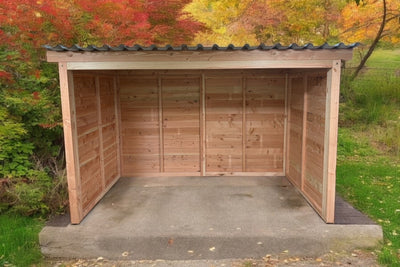Wind protection in the garden: security solutions for Swiss families
A garden in Switzerland should be more than just a piece of greenery - it is a place of retreat, a playground and an oasis of well-being all in one. Families with children in particular benefit from a safely designed outdoor area. However, in many regions of Switzerland, wind is a disruptive factor that should not be underestimated: it cools down, dries out the ground and can make playing outdoors uncomfortable. Targeted wind protection in the garden not only improves the microclimate, but also ensures greater safety in everyday life - especially for young children.
In this article, you will receive sound tips on the topic of wind protection in the garden - ideally tailored to Swiss weather conditions, DIY projects and the needs of families. You will learn which materials are particularly suitable, how to plan successfully and which regulations should be observed before construction. We also provide tips on maintenance and budgeting. Whether you want to build your windbreak yourself or hire a specialist company: Here you will find a wealth of knowledge for wind-protected garden enjoyment.
Why wind protection in the garden is indispensable for Swiss families

Strong winds are a daily occurrence in many Swiss regions such as the Jura, Central Plateau and Central Switzerland. Especially for gardens with play areas, an effective windbreak is not a luxury, but a sensible investment in safety and comfort. It allows children to play outside for longer and protects sensitive garden areas from drying out.
More safety for families with children
Wind can be dangerous in the garden - for example when gusts catch loose branches or toys. It increases the risk of accidents with play towers, swings or slides. A well-designed windbreak reduces these dangers and creates a stable environment for children of all ages.
Picnic blankets, sandpits and smaller garden furniture are also less exposed to the wind. Parents need to worry less about flying objects - and the garden remains clearer and neater.
Improved microclimate and longer garden season
Wind causes increased evaporation, which damages the soil and sensitive plants such as tomatoes, raised beds or young shrubs. With a windbreak, moisture is retained in the soil for longer - ideal for growing vegetables and ornamental plants.
People also benefit: Low-wind zones in the garden are warmer, more pleasant and more inviting to linger. The garden season is extended - whether you want to barbecue, read a book or watch your children play after work.
Windbreak materials: Which solutions suit the Swiss garden?
Choosing the right material for your windbreak is crucial. It's not just about looks, but also about weather resistance, maintenance and sustainability. In Switzerland in particular, materials should be able to withstand snow, rain and UV radiation in the long term.
Natural and durable variants
- Gabions with stone filling offer durable wind and privacy protection. They are easy to maintain and can be planted with natural plants.
- Wooden panels made of larch or Douglas fir are available regionally, weatherproof and particularly durable with the appropriate glaze.
- Hedges such as hornbeam, privet or cherry laurel create a harmonious effect, reduce wind pressure and provide a habitat for beneficial insects.
Plant-based solutions are particularly suitable for families for whom a natural garden is important. With a little patience, they are highly effective and thrive in the Swiss climate.
Robust materials for changeable weather
- Aluminum solutions with slats or panels are modern, corrosion-resistant and require little maintenance. Perfect for contemporary designs.
- Composite materials such as WPC have a wood-like feel but do not splinter - ideal for children and barefoot areas.
- UV-resistant windbreak nets are suitable for temporary areas such as a play tent, trampoline or raised beds.
Combined use - such as aluminum frames with wooden infill or gabions with hedges - can be visually appealing and functional at the same time. This creates an individual windbreak for your garden in Switzerland.
How to plan your windbreak step by step
The ideal windbreak solution starts with sensible planning. Think about where the wind is strongest and which areas of the garden are in particular need of protection. In Switzerland, different wind conditions can be expected depending on the slope, valley opening or building development.
Consider wind direction and garden structure
Over several days, analyze which directions the wind often comes from. Mark exposed zones on a garden plan. In small gardens, vertical elements or green lattice walls are recommended. Larger plots benefit from staggered wind protection zones consisting of hedges, half walls or planting beds.
Pay attention to permeability: semi-open structures slow down the wind without creating an unpleasant backdraft. This is particularly important in regions such as Graubünden, the Zurich Oberland or the Aargau hills.
Separate play areas and resting places
Position the windbreak so that recreation and play areas benefit directly. A sheltered seating area near the house or a windless corner by the sandpit significantly increases the usability of the garden.
Storm-proof ground materials such as natural grass, bark mulch or fall protection slabs are suitable additions. A low border around play areas can also reduce wind drifts.
Legal regulations for windbreaks in Switzerland
If you want to build a windbreak, you should know the legal framework. Depending on the municipality and canton, different regulations apply with regard to height, spacing and choice of material. Early clarification helps to avoid later conflicts or dismantling obligations.
Building hygiene and neighborhood law
Many municipalities allow wind barriers up to 1.80 m high without a formal planning application. However, minimum distances to the property boundary are important - usually 50 cm to 1 m. Hedges often also have regulated planting distances.
Information can be found on the websites of the local building authorities or, for example, at Federal Office for the Environment FOEN. Before starting construction, it is advisable to have a brief discussion with direct neighbors - this will help to avoid misunderstandings.
Observe playground standards and safety
Gardens with children under the age of six are subject to stricter requirements. Windbreak walls without edges and with splinter-free material are mandatory. Make sure that there is no risk of falling - especially with play equipment with a fall zone.
Although private gardens do not have to be officially certified, compliance with current standards such as SN EN 1176/1177 significantly increases safety - especially if several children regularly use the garden.
Care, maintenance and typical mistakes with wind protection systems
A windbreak must remain stable and functional in the long term. Regular checks are particularly important in the Swiss winter with snow loads or heavy storms. The amount of care required varies depending on the material.
Care instructions for popular materials
Wooden panels made of larch or Douglas fir should be treated with glaze every year. The best time is spring after the last frost. Hedges thank you for pruning in spring and fall with denser growth.
Metal or composite solutions are low-maintenance, but should be checked annually for rust, bolting and stability. After winter storms, check whether foundations have given way or ground anchors have loosened.
Avoid these classic mistakes
- No air circulation: Completely closed elements can generate turbulence. Use partially open structures or slanted slats.
- Unsuitable anchoring: A deep, frost-resistant foundation is necessary, especially for windbreak walls.
- Weak material: Thin plastic panels without UV protection lose stability in a short time.
Good planning and high-quality materials pay off in the long term - both in terms of appearance, safety and maintenance.
How much does a windbreak cost and how do I make a sensible calculation?
The cost of windbreaks varies depending on the material, size and personal contribution. In Switzerland, it is important to factor in maintenance and any foundations in addition to the purchase costs.
Price overview of common windbreak systems
- Wooden panels in a kit: CHF 80-150 per meter
- Aluminum elements: 120-250 CHF per meter
- Gabions with stone filling: 150-300 CHF per meter
- Hedge plants incl. planting: from CHF 40 per running meter
Accessories such as mounting anchors, glazes or foundation materials should also be taken into account. Professional installation by a gardening company costs CHF 50-120 per hour - depending on the region and experience.
Build it yourself or have it done by a professional?
Skilled gardeners can assemble wooden windbreaks or gabions themselves. DIY stores such as Coop Bau+Hobby, Jumbo or Hornbach Schweiz offer suitable systems.
For slopes, large gardens or combined privacy screen solutions, a gardening specialist is recommended. Platforms such as gartenbau.ch or renovero.ch can help you find a quote.
A realistic assessment of your own work is crucial for budget planning. Invest specifically in durable, safe and childproof components - for a garden that will continue to give pleasure in the future.
Conclusion: A windbreak makes your garden windless, safe and family-friendly
A well-planned windbreak improves life in the garden in many ways. It protects your children from playing, your plants from strong winds and creates cozy zones to relax and enjoy - regardless of the weather.
Choose materials that can withstand the Swiss climate and suit your style. With careful planning, regular maintenance and a realistic budget, you can create a garden that offers a sense of security and invites the whole family to linger.
Start your project now and turn your windy outdoor area into a safe, feel-good zone. You can find more tips on garden planning in Switzerland at garten.ch.


